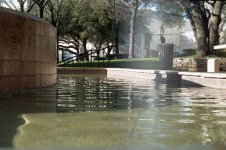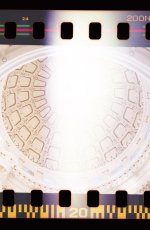You might double-check your negatives to see if they have the same streak as the prints...
Before I switched to the local Ritz agency for processing, I was getting "streaky" prints; it turned out to be a lab-problem, not a camera problem.
Also, just a quick observation from your first three pics: looks like the sun was behind you ( ?) so I'm wondering it if is (possible to be ) lens-flare ?
My first rolls from my III-f / Sumicron were shot into nearly into the late-afternoon sun, no hood, and the prints had all sorts of "spots" abberations, that I was certain were lens-flare; there were other shots in the same roll that were very good.
Eventually, I became aware that the curtains in my III-f are shot (crackled), and what I was thinking was lens-flare was actually caused by the leaky curtains.
I suppose it is possible that your shutter is dragging a bit in mid-travel; with the lens off and no film in the camera, set it at 1/20 or 1/30, and observe the curtain travel / shutter sound when you press the button: do the curtains seems to move smoothly and the clockwork sounds regular and smooth ?
If the curtains appear to hesitate or the clockworks change in pitch or sound, that could be a sign that things are dragging...
My III-f and D (black II ) both get really draggy when they've been out in the cold; that shows up as the right side of the print being darker than the left; sometimes the last 1/4 of the image on the right side is dark.
I recently got a pretty ugly III (chrome) with a really gummy shutter ( would'nt even fire a complete cycle on any speed. Deciding to make it a guinea-pig, I flooded a mix of Ronsonol and gun oil around the shutter release button, and the high-speed dial, and kept exercising the shutter. After about 1/2 hour of fiddling, I got all the speeds to work smoothly, even the slows, all the way down to 1 sec. I've been out shooting a couple of test rolls, in the cold, and it doesn't seem to mind the cold at all. This is not a replacement for a proper CLA, but will at least enable me to evaluate the shutter curtains, etc.
But I digress.
You might try another roll, keeping careful notes in one of those little pocket flip-pads, maybe even put the camera on a tripod, and shoot the same scene, trying all combinations of f-stop / shutter speed that your film/ light allows, until you've covered the camera's full range.
Once you've done that, if it's a bright sunny day, you could try shooting the same scene at different times of day, early, with the sun behind you, and later with the sun between 90 & 45 degrees to the film -plane ("shooting into the sun")... this should tell you "how" your Summitar flares, and perhaps better enable you to judge whether your lens or your camera is the culprit...
Just some thoughts based on my recent Leica experiences...
Good luck !
Luddite Frank








